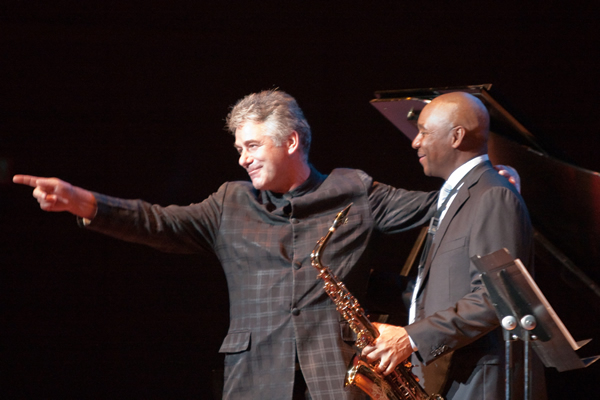The North Carolina Symphony opened its 2014-15 season in UNC’s Memorial Hall with a beautifully designed concert that exhilarated from start to finish. The scintillating program, with Grant Llewellyn on the podium and Branford Marsalis featured on the saxophone, repeats in Meymandi Concert Hall Sept. 19-20.
If somehow you have not yet heard Branford Marsalis, know that he is one of the best of the best saxophonists of our era. He may not be the hottest, or the most piercing, but he’s a subtle musician, and his sound is s-m-o-o-t-h. In addition to his extensive catalog of jazz recordings (and long roster of awards), he has composed music for the stage and, since the beginning of this decade, has been appearing as guest soloist with symphony orchestras around the world. Fortunately for us, this member of the musical Marsalis family lives in Durham, and the NCS is his “home” orchestra. (Marsalis is a member of the NCS board of directors.)
After kicking off with an ebullient rendition of “The Star-Spangled Banner” by the full orchestra (Llewellyn singing and conducting both the musicians and the audience), the concert began with Leonard Bernstein’s eight-movement Divertimento for Orchestra, which he wrote for the Boston Symphony’s centennial season in 1980. Energetic and many-faceted, the delightful piece in a succession of forms (waltz, mazurka, etc.) is identifiably Bernstein, with the humor and vitality heightened by shadowy sounds of sorrow and struggle. There are passages, especially in the “Sphinxes” section, that recall his Dybbuk of 1974.
Two works featuring the saxophone formed the core of the concert. Jazz Concerto (Hot Sonata), by the short-lived Czech composer Erwin Schulhoff, came first. It premiered in 1930 as a piece for sax, piano, and dance band, but the English composer Richard Rodney Bennett gave it a rich orchestration ten years ago. Although the four movements are a bit predictable, they are nonetheless enjoyable, and they allowed Marsalis plenty of leeway to do that thing he does that makes the listener feel like hot taffy being pulled into suave elasticity. The ending of the final movement (molto vivo) is very smart and makes one reconsider the apparently easy pleasures of the earlier movements.
No reconsideration is needed of the Concerto in E-flat Major for Saxophone and String Orchestra, Op. 109, by Alexander Glazunov, which premiered in 1934. Here the saxophone plays with the full complement of strings, but no other instruments, and the textures are fabulous. The three movements flow together into one panoramic experience. It generated a cinematic tour of landscapes in my mind’s eye – some vast, some intimate – with the tour guide commentary given by the saxophone’s golden notes. It spoke in the voices of Pan, of yearning woodland nymphs and bold naiads and, near the end, when the strings make a kind of net for the saxophone notes to dart through, it spoke in the voice of Terpsichore herself. The work received a prolonged, roaring standing ovation in Memorial Hall.
The evening closed with the program’s oldest work, La Mer, from 1903, by Claude Debussy (who died in 1918, the year Leonard Bernstein was born). It’s the musical equivalent of a roomful of seascapes, with the ever-changing light and color coming at you from all directions. Although the saxophone is not included, the strings of the orchestra are joined by many brass and woodwind instruments, plus the timpani and two harps. When the wind rose in the final of the three movements, all you could do was clutch the gunwales – I mean the arms of your seat – while the storm whirled around you and the waves beat the little boat on the frothing sea. It was totally thrilling, and after you got your breath back, it may have occurred to you that it took a first-class orchestra led by a compelling, charismatic conductor to execute so brilliantly the thousands of vying patterns that make up such excellent chaos.
As noted, this program will be repeated in Raleigh on Sept. 19-20. For details, see the sidebar.











